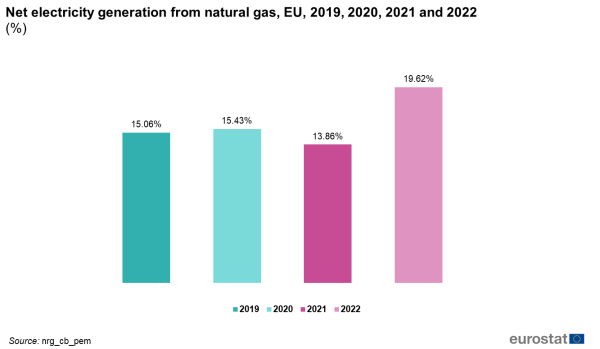Energy statistics - latest trends from monthly data
Data extracted in April 2023
Planned article update: 12 June 2024
Highlights
Imports of crude oil and petroleum products from Russia into the EU down by 60 % during 2022.
Almost every Member State consumed less electricity and gas in 2022 than in 2021.
This interactive graph shows electricity production in the EU by month, with a breakdown of the fuel types that were used to produce it.
Introduction
After the almost complete post-COVID economic recovery in 2021 further stabilisation of the energy market was expected in 2022. However, at the beginning of 2022, in response to the war of aggression against Ukraine, the EU began imposing sanctions against Russia, the largest supplier of fossil fuels to the EU. By June 2022, the Council adopted the sixth package of sanctions that, amongst other things, prohibited the purchase, import or transfer of coal and other solid fossil fuels, crude oil and certain petroleum products from Russia into the EU. This, together with the transition to renewable energy and the increasing energy, oil and gas prices at the end of 2021 the energy sector faced an enormous challenge. This article looks at certain aspects of fuel supply from the recently available monthly data for 2022 for different fuels in the European Union (EU), and compares it with those of 2019 to 2021 to observe the trends and differences the sanctions may or may not have made in the EU's energy market.
Full article
Coal consumption
The use of solid fossil fuels in the EU has been declining steadily for years. Due to high CO2 prices (see EU emission trading scheme), many Member States have been reducing their use of coal for electricity generation. However, during the last two years, the figures for hard coal used in power and heat generation have been increasing gradually. In 2022, 74.8 % of all coal consumed in the EU was delivered to electricity and heat generation plants, compared to 72 % in 2021. For hard coal these figures were 52 % in 2022 and 46 % in 2021, and for brown coal the figures are almost identical, 86.9 % and 87 % respectively.
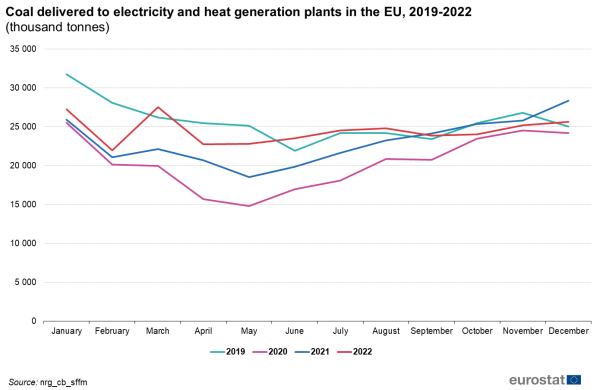
Source: Eurostat (nrg_cb_sffm)
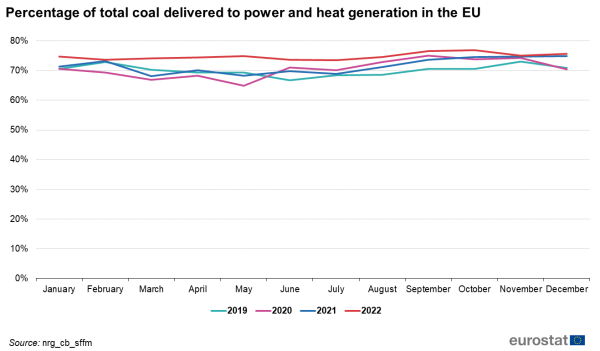
Source: Eurostat (nrg_cb_sffm)
Several EU countries have stopped producing hard coal, but despite this, almost all EU countries still consume hard coal. The total amount of hard coal consumed in 2022 was very similar to 2021, 160 882kt to 160 810kt respectively. Figure 3 shows the monthly consumption of hard coal in the EU in 2019, 2020, 2021 and 2022. Figure 4 shows the same but for brown coal. The lowest consumption levels were observed in early to mid-2020, but by the end of 2021 consumption of both hard coal and brown coal were back to the average levels for 2019.
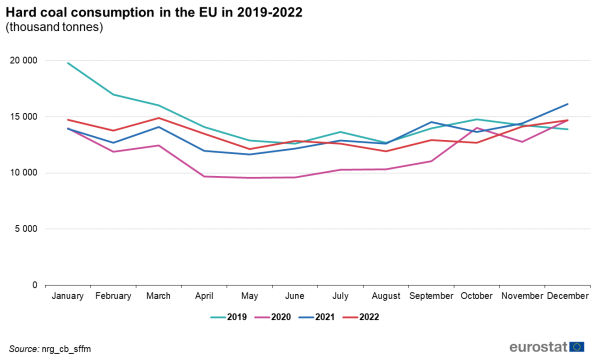
Source: Eurostat (nrg_cb_sffm)
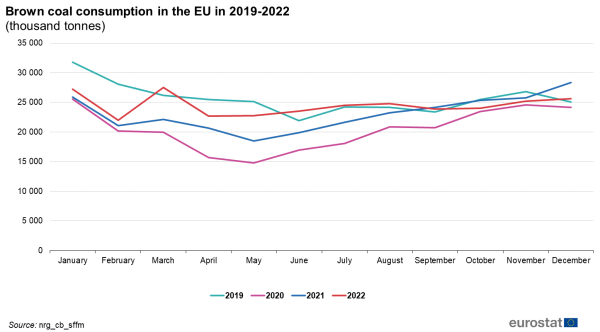
Source: Eurostat (nrg_cb_sffm)
Crude oil and petroleum products
In June 2022, the Council adopted a sixth package of sanctions that, among others, prohibits the purchase, import or transfer of seaborne crude oil and certain petroleum products from Russia to the EU. As the majority of the Russian oil delivered to the EU is seaborne, these restrictions will cover nearly 90 % of Russian oil imports to Europe by the end of 2022. Even though the oil and petroleum products sanctions applied from 5 December 2022 (crude oil) and from 5 February 2023 (refined petroleum products), many Member States sped up or initiated their own plans aimed at reducing import from Russia almost immediately the war of aggression began. While demand stayed stable, imports from Russia decreased from 15 723 thousand tonnes to 6 247 thousand tonnes in just 12 months.
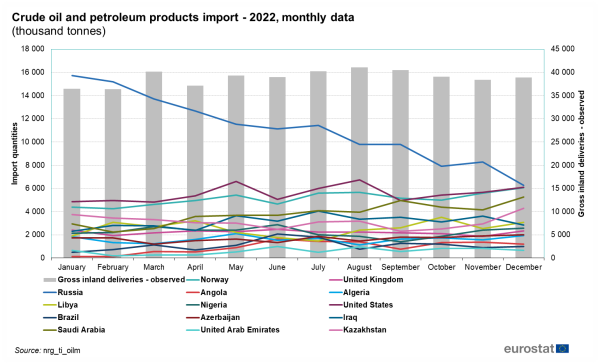
Source: Eurostat (nrg_ti_oilm)
The gap between demand and decreasing import from Russia was filled in two ways: 1) The emergency stocks required by EU law allowed for two emergency stock releases in 2022 in order to stabilise the market. 2) Import from other countries increased significantly. Compared to 2019 the United States increased their annual export to the EU by 25 813 thousand tonnes (+63.39 %), Norway by 16 695 thousand tonnes (+37.35 %), Brazil by 8 710 thousand tonnes (+194.32 %), Angola by 4 139 thousand tonnes (+56.94 %) and the United Arab Emirates by 1 434 thousand tonnes (24.37 %).
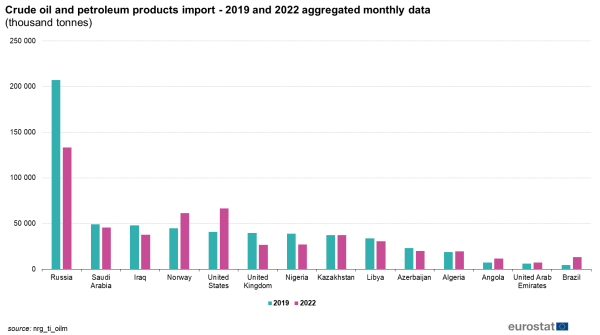
Source: Eurostat (nrg_ti_oilm)
Another aspect of the problems faced in the energy sector last year, were the volatile prices, including those for crude oil imports. In the graph below, information on the average price paid per barrel of crude oil imported into the EU is shown – as per the industry standard, oil prices are expressed in US Dollars per barrel ($bbl). The extreme volatility of the average price is clearly visible.
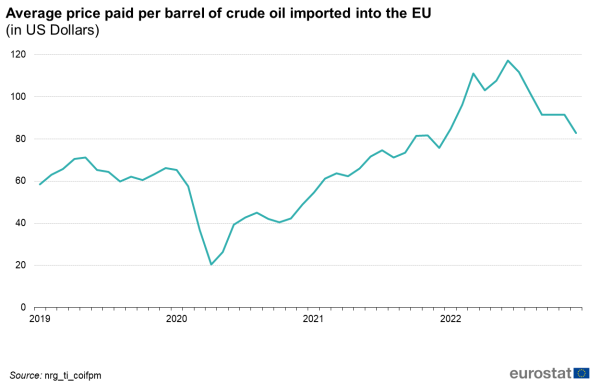
Source: Eurostat (nrg_ti_coifpm)
For more information please see Eurostat’s article Crude oil imports and prices: changes in 2022.
Electricity consumption
Most economic activities depend on electricity. Therefore, electricity consumption is a possible indicator for economic development. Figure 8 below shows the total electricity consumption of EU-27 in Gigawatt hours (GWh) for the years 2019, 2020, 2021 and 2022. In spring 2020, the line shows a dramatic drop in electricity consumption, which is in close correlation to the first imposed COVID-19 restrictions. The graph also shows that in 2021 electricity consumption was almost back to pre-COVID-19 levels. On 24 February 2022, Russia began its unjustified military aggression against Ukraine and gas supplies from Russia to Poland and Bulgaria stopped in April. The gas delivered via the Nordstream pipeline was reduced in June and finally stopped at the end of August. By autumn, Member States were asked to reduce their demand for natural gas by 15 %, including for electricity generation. We can see a lower electricity consumption already starting in August 2022 until the end of the year.
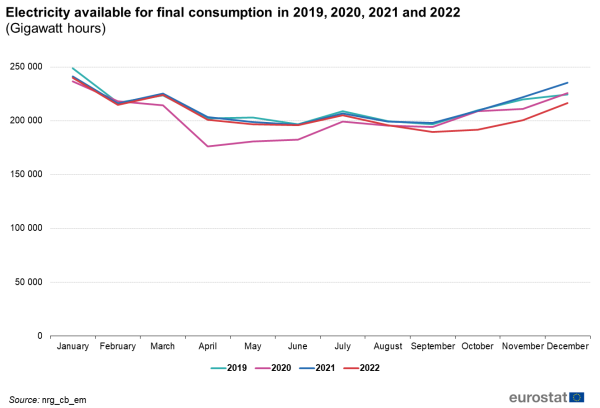
Source: Eurostat (nrg_cb_em)
Figure 9 below shows the difference in electricity consumption in each of the Member States between 2022 and 2021. Almost every Member State consumed less electricity in 2022 than in 2021. While Malta (+7.9 %), Portugal (+4.2 %), Ireland (+3.0 %) and Cyprus (+2.8 %) consumed more electricity, all other Member States consumed less from -0.4 % in Italy to -9.4 % in Slovakia.
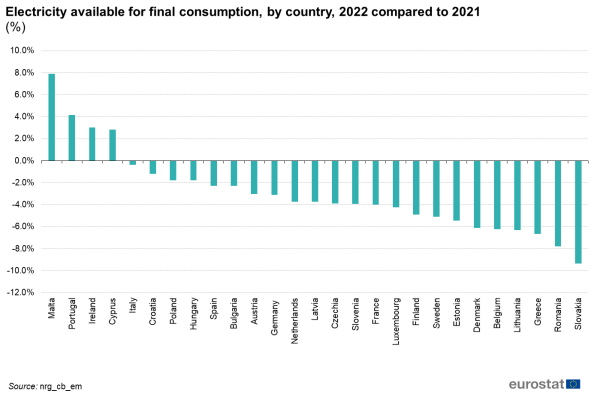
Source: Eurostat (nrg_cb_em)
An important additional factor is the heating or cooling of space or sanitary water for which certain Member States mostly use electricity. When interpreting the data, the fact that each country has its own consumption pattern and that these can be heavily dependent on outside temperatures must be taken into account.
Gas consumption
Natural gas is used in the production of electricity and heat. Figure 10 shows that in 2022, 19.6% of electricity produced in Member States was generated from natural gas. Almost a quarter (24.6%) of natural gas consumed by Member States was used to generate electricity.
Figure 11 shows the levels of natural gas consumption in the EU by month over the last four years. The graph uses data from the monthly questionnaires and it shows a clear reduction in natural gas consumption across Europe in 2022 when compared to the previous 3 years. In fact, consumption of natural gas in the EU has dropped steadily in the period August 2022-December 2022, compared with the average gas consumption for the same months (August-December) between 2017 and 2022. Looking at monthly data from January 2022 to December 2022 (Figure 11), with the exception of March and April, consumption has been consistently below the 2017-2022 average of the respective months of those years. Between January and July 2022, natural gas consumption in the EU varied between 1 938 Petajoules (PJ) in January and 785 PJ in July, indicating a monthly decrease overall, even before the target of 15% gas reduction was set up by the Council Regulation (EU) 2022/1369. But the biggest decreases were registered in the second semester of the year starting in August 2022, with a 14.0% reduction in consumption, followed by 14.3% in September, 24.7% in October and 25.0% in November. Consumption in December 2022 rose to 1 575 PJ, indicating a smaller decrease (12.6%) than in previous months.
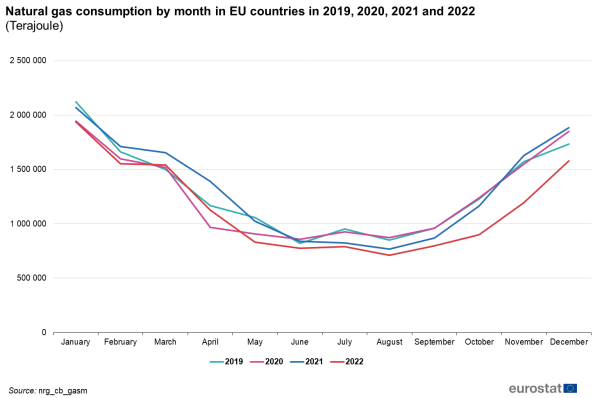
Source: Eurostat (nrg_cb_gasm)
For more information on gas consumption reduction at the end of 2022, please see the Eurostat article EU gas consumption down by 20.1% (20/12/2022).
Source data for tables and graphs
Data sources
All annual values for 2019-2022 were calculated by adding the monthly data for each calendar year. All annual data used in this article correspond to totals of monthly data and as such may differ from the annual data. The reporting is based on Energy Statistics Regulation (EC) No 1099/2008.
Context
To better monitor changes in the energy market, timely data is essential to all involved. Eurostat, therefore, not only collects detailed annual energy statistics but also a reduced number of data points on a monthly basis. This monthly energy data contains information on supply and a limited amount on consumption, but can be published within two to three months, providing very early data on the energy market in each Member State and in the EU as a whole.
Direct access to
See also
Database
- Energy (nrg), see:
- Supply, transformation and consumption - commodity balances - monthly data (nrg_cb_m)
- Supply and transformation of solid fossil fuels - monthly data (nrg_cb_sffm)
- Supply and transformation of oil and petroleum products - monthly data (nrg_cb_oilm)
- Supply, transformation and consumption of gas - monthly data (nrg_cb_gasm)
- Supply, transformation and consumption of electricity - monthly data (nrg_cb_em)
Dedicated section
Publications
- Energy, transport and environment statistics - 2020 edition
- Energy data - 2020 edition
- Sustainable development in the European Union — Monitoring report on progress towards the SDGs in an EU context — 2020 edition
- Shedding light on energy in the EU — A guided tour of energy statistics — 2020 edition
Methodology
- Energy statistics - quantities (European and national ESMS metadata file — nrg_quant_esms)
- Energy statistics - supply, transformation, consumption (monthly) (ESMS metadata file — nrg_10m_esms)
Legislation
Regulation (EC) No 1099/2008 on energy statistics
Visualisations
- Explore monthly energy data - This interactive tool helps you to obtain an overview of seasonal energy trends in Europe or your country.
- European Statistical Recovery Dashboard
External links
- European Commission - Directorate-General for Energy
- European Commission - Directorate-General for Energy - Weekly oil bulletin
- European Commission - Directorate-General for Energy - Data and analysis
- Joint Organisations Data Initiative - monthly oil and natural gas world database
- International Energy Agency - monthly statistics
